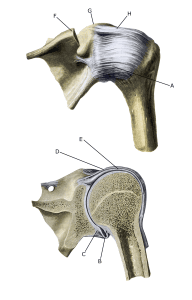Anatomy
The shoulder joint consists of the humeral head of the humerus (caput humeri) and the articular surface of the scapula (cavitas glenoidalis). A meniscus (labrum glenoidale) runs all the way around the edge of the shoulder blade’s articular surface.The joint is surrounded by a joint capsule that is reinforced by several ligaments. Surrounding the joint capsule are the shoulder muscles that further reinforce the joint.
Shoulder joint:

A. Capsula articularis
B. Capsula articularis
C. Labrum glenoidale
D. Capsula articularis
E. M. biceps brachii
(caput longum)
F. Acromion
G. Processus coracoideus
H. Ligamentum coracohumerale
Cause
The cause of the development of a frozen shoulder is partly unknown. In some cases, pain from, for example, shoulder bursitis triggers painful shrinkage of the joint capsule in the shoulder, causing pain and reducing movement in all directions.
In other cases, a sudden trauma (or shoulder surgery) or other diseases are the triggering cause. In some cases, the cause is unknown.
The condition is most common in 40-60 year olds and much more common in diabetics. There is a modest heredity associated with the condition (Pimenta M, et al 2023).
Symptoms
Pain usually occurs in the shoulder, which in many cases is caused by inflammation of the bursa (bursitis subacromialis). After a few months, the movement of the shoulder joint is restricted so that all movements are reduced.
After up to 7 years (on average a couple of years), the pain subsides and after a few more months the mobility of the shoulder joint normalises.It is rare to get frozen shoulder more than once in the same shoulder.
Examination
The diagnosis is usually made on general clinical examination.There is typically restriction of movement in all directions, including when the arm is passively rotated outwards (compared to the healthy side). In case of doubt, an ultrasound scan (or MRI scan) can be supplemented (Pimenta M, et al. 2023).
Treatment
As the condition is benign and usually heals spontaneously, you should be cautious with treatments that carry risks of side effects (e.g. surgery). Light painkillers (paracetamol) or possibly arthritis pills (NSAID) are usually advised if needed. In case of ineffectiveness or severe discomfort, an ultrasound-guided injection of adrenal cortical hormone can be injected into the shoulder joint and into the bursa if it is inflamed (Pimenta M, et al. 2023). Surgery is associated with some complications and is rarely not indicated (Pimenta M, et al. 2023).
Complications
Anyone with frozen shoulder should be medically examined to ensure the diagnosis is correct.
In particular, the following should be considered:
- Rupture of the upper shoulder blade muscle
- Inflammation of the tendon sheath of the upper shoulder blade muscle
- Meniscus lesion in the shoulder
- Muscle infiltrations
- Nerve entrapment on the back of the shoulder blade
Your GP will also consider the indication for a chest X-ray and blood glucose testing, as the condition has been described as slightly more common in lung cancer and much more common in diabetes.
